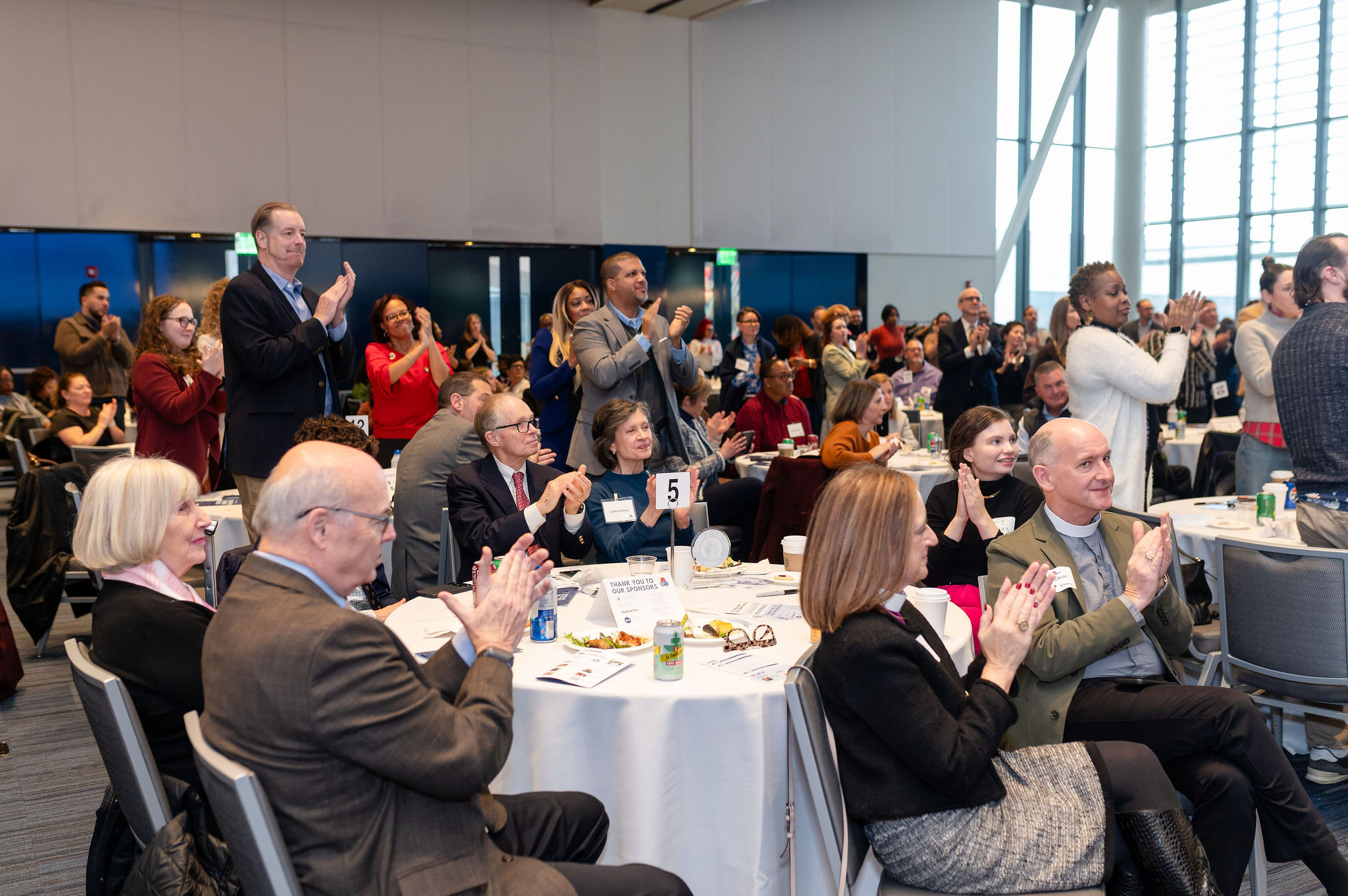Happy Pride! This month, millions of LGBTQ+ folks and allies will gather to celebrate the positive ways members of LGBTQ+ community have shaped the world we live in. It’s also when we commemorate the violence and inequity inflicted upon the queer community. But amidst these wonderful celebrations of LGBTQ+ visibility, it’s critically important to acknowledge the absence of LGBTQ+ status in almost all our local, state, and federal data.
This invisibility has been described as creating a “data desert” by the Director of the Program for LGBT Health at Drexel University, one that affects the approximately seven percent of Americans who are gay, lesbian, or bisexual, and the 1.6 percent who are transgender or non-binary. That’s a stunning 23.2 million gay, lesbian, and bisexual Americans, and 5.3 million transgender or non-binary Americans whose identities, and therefore experiences, are ignored in the data.
An absence of data can be harmful
Without comprehensive data, the unique needs of LGBTQ+ people are more likely to be unknown, ignored, and underfunded. It is also more difficult to advocate on behalf of policies and programs that benefit LGBTQ+ people. Analysis of how programs or policies specifically affect members of the LGBTQ+ community cannot be reliably conducted with current data collection practices. See the 2019 report from the Human Rights Campaign Foundation, LGBTQ-Inclusive Data Collection: A Life Saving Imperative, for a comprehensive review of the ramifications of this invisibility.
The decision to measure something is often indicative of the value placed on understanding it.
The decision to measure something is often indicative of the value placed on understanding it. But this data desert is in part a result of the danger the LGBTQ+ community experiences in making their gender identities and/or sexualities known. The United States has a history of criminalizing and discriminating against people who are LGBTQ+. Once considered a disease, our medical institutions incorporated all kinds of horrors to “cure non-conforming identities.” Our scientific institutions called “homosexuality” a mental disorder as recently as the 1970s, and trans individuals experiencing a mismatch in their gender identity and sex assigned at birth was labeled a disorder up until 2013. Our military banned and dishonorably discharged 17,000 “homosexual” men and women in the 1980s, before enacting the Don’t Ask, Don’t Tell policy from 1994-2011. Under Don’t Ask, Don’t Tell, roughly 13,000 service members were still discharged for “homosexual conduct admission” during this time.
A signal of change came in 2015 when the Supreme Court narrowly ruled that all states must both license marriages between same sex couples and recognize all marriages that were performed out of state. It’s impossible to detail all the injustices members of the LGBTQ+ community have experienced at the hands of our laws, institutions, and the American people.
But it’s incorrect to talk of this discrimination as only history; over 500 anti-LGBTQ+ bills were introduced in state legislatures in 2023 alone. And it is perfectly legal in much of Ohio for “LGBTQ Ohioans to be fired from their job, denied housing, asked to leave a public facility, or denied access to the appropriate restroom,” because statewide nondiscrimination bills are unable to pass the Ohio legislature. This discrimination and danger play a role that is difficult to fully understand in suppressing the stories and data of LGBTQ+ peoples.
Addressing the data desert
The best way to address this data desert is to safely collect comprehensive data when able. This is why Community Solutions has been a supporter of Andrew Snyder and teams’ amazing work on the LGBTQ+ Community Needs Assessments in Greater Akron and Greater Cleveland, which aimed to prioritize safe and trustworthy data collection by regularly seeking input on data collection from individuals from the LGBTQ+ community and using a team of community leaders and stakeholders to guide the process.
The Center for Community Solutions strongly supports the progress made in the Census Bureau’s decision to begin collecting sexual orientation and gender identity data in the American Community Survey. This change has the potential to create a rich body of data for researchers, advocates, and policymakers alike, to explore and better understand the broad experiences of members in the LGBTQ+ community. As Dr. Badgett, an economics professor at University of Massachusetts explains, “We can learn about health, economic, housing and other outcomes that might be worse for LGBT people because of the stigma and discrimination that they face, and we can track changes over time to see if laws and policies are leading to more equality.”
We can learn about health, economic, housing and other outcomes that might be worse for LGBT people because of the stigma and discrimination that they face.
This is a welcome improvement to one of The Census Bureau’s most established and widely used products! Prior to this update, the Census Bureau was limited to making inferences about same-sex couples by analyzing the probable genders of names, and much more recently Census products began asking about spouse/unmarried partner gender directly, allowing the Bureau to identify gay and lesbian partners in the data. However, in 2020, the Census Bureau created the Household Pulse Survey, an experimental tool designed to quickly gather information about the rapidly changing needs of the American people as we navigated the COVID-19 pandemic. In 2021, for the first time ever on a census-sponsored product, sexual orientation and gender identity data was asked. And immediately the importance of that update was made clear. Early findings of this new data evidenced that “Lesbian, Gay, Bisexual or Transgender (LGBT) respondents […] were more likely than non-LGBT respondents to experience economic and mental health hardships during the COVID-19 pandemic.”
More in-depth analysis that explored changes in this data over an 18-month period from July 2021 to December 2022 concluded, “The most obvious result is that sexual minorities, or respondents answering other than straight to the sexual orientation question, were more likely than straight respondents to face each type of hardship”, and that “Transgender respondents were most likely to face multiple hardships, while respondents identifying as transgender or ’none of these’ [meaning a respondent didn’t see themselves as male, female, or transgender] were most likely to face financial insecurity.”
These findings align with what the author identified as a growing body of research finding disparities between members of the LGBTQ+ community and straight cisgendered people. These disparities found in the Household Pulse Survey highlight the importance of asking respondents about their sexual orientation and gender identity.
What does the data say about Ohio?
The Pulse data provides insight at the state level, which allows us to explore and make inferences about Ohioans of different sexualities and genders are faring. The charts below specifically detail some of these explorations for Ohioans who are lesbian, gay, bisexual, unsure of their sexuality, or some sexuality other than straight (coded in the data as ‘LGB+’), as well as for straight Ohioans. All data reported comes from the Census Pulse Phase 4.1, which was collected from April 2nd through April 29th, 2024. All original tables can be found here.
Difficulty paying for usual household expenses in the last 7 days

Respondents who experienced loss of employment income in the last four weeks

Respondents who didn’t always have enough to eat in the last seven days

Frequency of feeling nervous, anxious, or on edge the last two weeks

Frequency of feeling down, depressed, or hopeless last two weeks

Feelings of Loneliness

Across the six measures, Ohioans who were lesbian, gay, bisexual, unsure of their sexuality, or some sexuality other than straight(LGB+), consistently had worse outcomes compared to Ohioans who were straight. These disparities were especially alarming when it came to rates of mental health and wellbeing, concerns that have been well established in extensive research literature.
One in every ten LGB+ Ohioan always felt lonely.
For example, three times more LGB+ Ohioans reported feeling down, depressed, or hopeless most of the time than straight Ohioans (26 percent compared to 8 percent). Relatedly, 65% of LGB+ Ohioans experienced feelings of loneliness at least some of the time, compared to only 39 percent of straight Ohioans.
One in every ten LGB+ Ohioan always felt lonely.
Pulse data limitations
While this information is insightful, the Census Pulse has multiple significant limitations that must be considered. For example, the tool suppresses data from smaller sample sizes of specific subpopulations, which means for some responses to certain questions, data is not available. This limitation should fortunately be addressed with the updates to the American Community Survey.
There are also substantial amounts of missing data from respondents choosing not to identify their gender, which means I was unable to reliably examine the experiences of transgender Ohioans in this dataset. This is unfortunate given the recent rise in rhetoric and legislation aimed at harming trans people nationally and in Ohio.
Despite these significant limitations, there is still value in exploring these differing experiences to show disparities. For this analysis, many outcome categories, as well as all respondents of sexual minorities were collapsed in order to create and report larger samples of respondents.
Final Thoughts
Some data, if credible, is better than no data. But for the lawmakers, leaders, teachers, advocates, and concerned community members invested in bettering their communities and supporting their LGBTQ+ neighbors, these statewide estimates can only go so far. The experience of someone who lives in Columbus may look different from someone who lives in Chillicothe, or Oberlin, or Akron, or Lima. Differences that are lost in statewide data.
We must acknowledge that it isn’t a simple task to start collecting such personal information. Fortunately, there has been a lot of important work done on best practices for asking about sexual orientation and gender identity, and there is political will to push federal agencies to begin collecting this data, and exploring how to best collect it.
There will still be some part of the LGBTQ+ community who will understandably not want to disclose that information out of concerns for their safety.
It is also important to acknowledge that even as it becomes more commonplace to collect sexual orientation and gender identity information, there will still be some part of the LGBTQ+ community who will understandably not want to disclose that information out of concerns for their safety. There is a history of tools like the Census being used to uphold dangerous white supremacist ideas that cannot be ignored, and as recently as the 2020 decennial census, there was significant and founded concern about the census asking about immigration status. Thankfully this didn’t happen. But even considering the complexity of asking these questions, and the understanding that there will always be some level of missing data as some members of the LGBTQ+ community protect themselves, this information is too important to not ask, and the ramifications of not knowing too dire for all of us.








